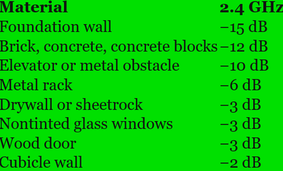Gain and Loss
. . . .
Gain and Loss
Both gain and loss are measured in a relative power called dB.
Gain
Loss
Both gain and loss are measured in a relative power called dB.
Gain
- Gain is also know as amplification
- Amplification is the increase in amplitude/signal strength
- Two types of gain
- Active gain
- Caused by the transceiver, capable of transmitting at different power levels
- Use of an amplifier connected on the wire between the transceiver and antenna
- Amplifiers are typically bidirectional. They increase AC voltage inbound and outbound
- Passive gain
- Accomplished by focusing the RF signal with the use of an antenna
- Does not require an external power source
- Internal workings of the antenna focus the signal more powerfully in one direction than another
- Active gain
Loss
- Loss is also known as attenuation
- Attenuation is the decrease of amplitude/signal strength
- Two types of attenuation on the wire:
- RF cable
- AC electrical signal will lose strength due to electrical impedance of coax cabling, connectors, lightning arrestsors
- Intentional
- RF engineers may add a hardware attenuator device on the wired side to remain compliant with power regulations or capacity design purposes
- RF cable
- Three types of attenuation in the air:
- Absorption
- As RF signal passes through different mediums, the signal is absorbed
- Absorption
- Distance
- FSPL (Free Space Path Loss)
- Effects of Multipath
- Reflection propagation can produce negative effects of multipath, resulting in the attenuation in signal strength
- Reflection propagation can produce negative effects of multipath, resulting in the attenuation in signal strength
Reference:
Coleman, David D.,Westcott, David A. CWNA: Certified Wireless Network Administrator Official Study Guide: Exam CWNA-106 Wiley.
Coleman, David D.,Westcott, David A. CWNA: Certified Wireless Network Administrator Official Study Guide: Exam CWNA-106 Wiley.
|
|

